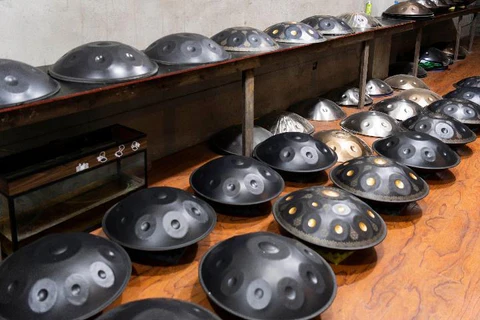Handpan for Beginners: Your Ultimate Guide to Getting Started

Have you ever heard a sound so pure, so captivating, it seems to resonate deep within your soul? That’s the magic of the handpan. Its ethereal tones and mesmerizing melodies have captivated musicians and enthusiasts worldwide, offering a unique blend of tranquility and creative expression.
There’s something about the handpan’s gentle vibrations and soothing harmonies that speaks to something primal within us. It’s an instrument that invites you to listen, to feel, and to connect with your inner self.
Whether you’re a complete beginner, drawn to the handpan’s enchanting call, or a seasoned musician looking for a new avenue of expression, this comprehensive guide, “Handpan for Beginners,” is your ultimate resource. We’ll walk you through everything you need to know to get started, from choosing your first instrument (including tips for searching “handpan near me”) to mastering basic techniques and exploring the nuanced world of handpan music.
What is a Handpan?
Often mistaken for a steel drum (which is played with mallets), the handpan is a unique instrument crafted from two metal shells joined together. The top shell “Ding” features precisely tuned indentations, or tone fields, which produce different notes when struck by hand. The bottom shell, known as the “gu,” often has a port for resonance. Handpans come in various scales and tunings, each offering a distinct sonic character.
See also: PLA Filament Buying Guide: Top Tips for 3D Printing
Why Learn the Handpan?
Beyond its captivating sound, the handpan offers a unique and rewarding musical experience.
- Intuitive Playability: Unlike many instruments that require years of dedicated practice to produce a pleasant sound, the handpan is relatively easy to pick up. Even beginners can quickly learn to play simple melodies and rhythms.
- Creative Expression: The handpan encourages improvisation and exploration. Its intuitive layout allows you to discover your own musical voice and create unique melodies.
- Mindfulness and Meditation: Playing the handpan can be a meditative practice, fostering focus, relaxation, and a deeper connection with sound.
- Portability: Handpans are relatively portable, making them easy to transport and play in various settings.
Choosing Your First Handpan
The world of handpans can seem overwhelming at first, with so many options available. Don’t worry! This section simplifies the process, outlining the key factors to consider when choosing your first handpan so you can make a confident and informed purchase.
- Scale and Tuning: Handpans come in a variety of scales and tunings, each with a distinct mood and character. Research different scales and listen to their sounds to find one that resonates with you. Common scales include the “D minor” (often considered a good starting point), “C major,” and various pentatonic scales.
- Number of Notes: The number of notes on a handpan can vary. More notes offer a wider range of melodic possibilities but can also be more challenging for beginners. A handpan with 9 or 10 notes is a good starting point for most beginners.
- Material and Craftsmanship: The quality of the materials and craftsmanship can significantly impact the sound and durability of a handpan. Look for reputable makers who use high-quality materials and have a good reputation for their craftsmanship.
- Budget: Handpans can range in price from a few hundred to several thousand dollars. Set a budget before you start shopping, and be realistic about what you can afford.
- Where to Buy: You can buy handpans online from reputable retailers or directly from makers. If possible, try playing with a handpan before you buy it to ensure it meets your needs and preferences. Searching for “handpan near me” might lead you to local shops, but online marketplaces often offer a wider selection.
Basic Handpan Techniques
Once you have your handpan, it’s time to start learning the basics:
- Striking Techniques: The most common way to play the handpan is by striking the tone fields with your hands. Experiment with different striking techniques to produce different sounds. You can use your fingertips, knuckles, palms, and even the sides of your hands.
- Rhythm and Timing: Developing a good sense of rhythm and timing is essential for playing the handpan. Start with simple rhythms and gradually work your way up to more complex patterns. Use a metronome or drum machine to help you develop your timing.
- Scales and Melodies: Learning scales and melodies is crucial for playing the handpan. Start with simple scales and gradually learn more complex ones. Practice playing melodies in different keys and modes.
- Improvisation: Improvisation is a key element of handpan playing. Once you’ve learned the basics, start experimenting with improvisation. Let your creativity flow and explore different melodic and rhythmic possibilities.
Handpan Care and Maintenance
Proper care and maintenance are essential for keeping your handpan in good condition:
- Cleaning: Regularly clean your handpan with a soft, dry cloth to remove fingerprints and dust. Avoid using harsh chemicals or abrasive cleaners.
- Storage: Store your handpan in a safe place where it won’t be exposed to extreme temperatures or humidity. A padded case or bag is recommended to protect your handpan during transport.
- Tuning: Handpans can go out of tune over time. If you notice that your handpan sounds out of tune, it’s best to have it tuned by a professional.
Learning Resources
Many resources are available to help you learn the handpan:
- Online Lessons and Tutorials: Numerous online platforms offer handpan lessons and tutorials, both free and paid. These resources can be a great way to learn at your own pace.
- Handpan Teachers: Finding a qualified handpan teacher can significantly accelerate your learning. A good teacher can provide personalized instruction and guidance.
- Handpan Communities: Connecting with other handpan players can be a valuable source of support and inspiration. Join online forums or local handpan groups to connect with other enthusiasts.
Tips for Getting the Most Out of Your Handpan Journey
Learning the handpan is a unique and personal journey. These tips are designed to support you every step of the way, offering guidance and encouragement as you explore the beautiful world of handpan music.
- Practice Regularly: Consistent practice is key to improving your handpan skills. Even short, regular practice sessions are more effective than sporadic, longer ones.
- Be Patient: Learning any musical instrument takes time and patience. Don’t get discouraged if you don’t see results immediately. Enjoy the process of learning and celebrate your small victories.
- Listen Actively: Listen to recordings of skilled handpan players to develop your ear and refine your technique.
- Experiment and Explore: Don’t be afraid to experiment with different playing techniques and explore your own musical voice.
- Have Fun! The most important tip is to enjoy the process! Learning the handpan should be a fun and fulfilling experience.
Conclusion
The handpan is a truly magical instrument, offering a unique and rewarding musical journey. Whether you’re drawn to its captivating sound, its intuitive playability, or its meditative qualities, the handpan has something to offer everyone.
By following this guide and dedicating yourself to practice and exploration, you’ll be well on your way to unlocking the magic of the handpan and creating your own beautiful music. So, pick up your handpan, let your creativity flow, and enjoy the journey!



